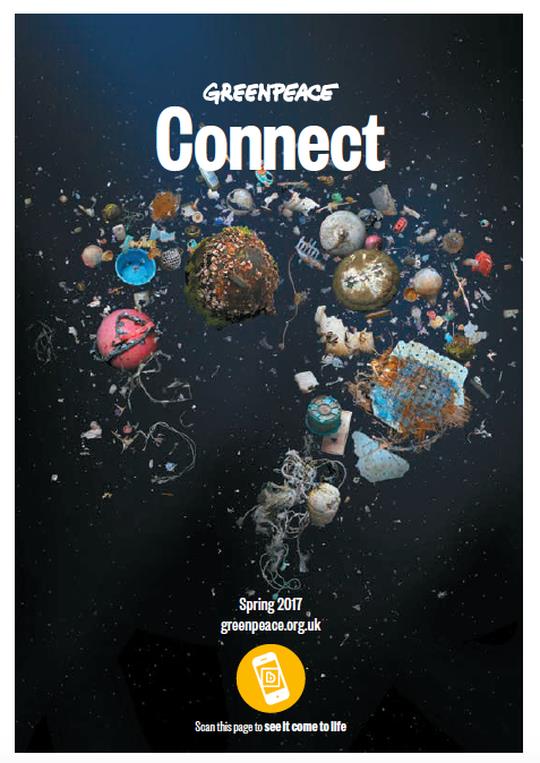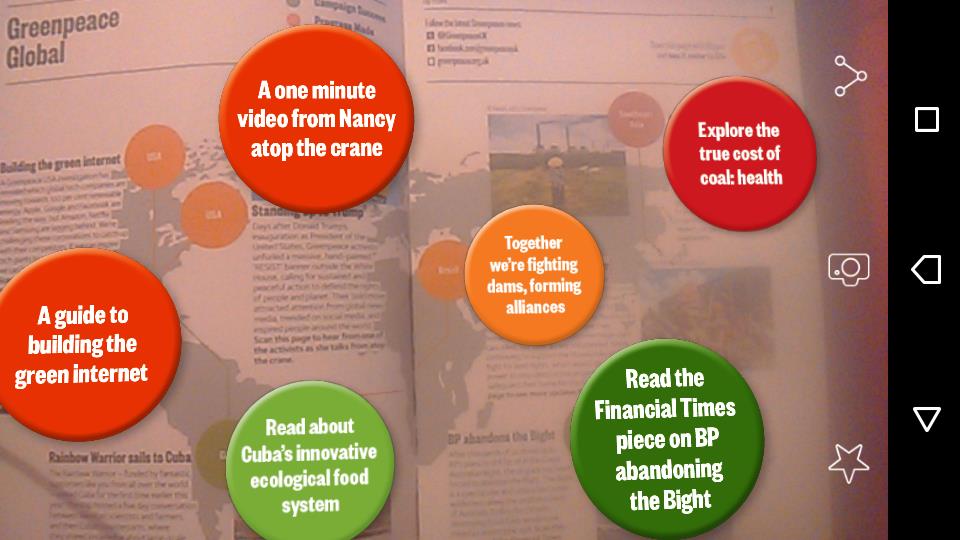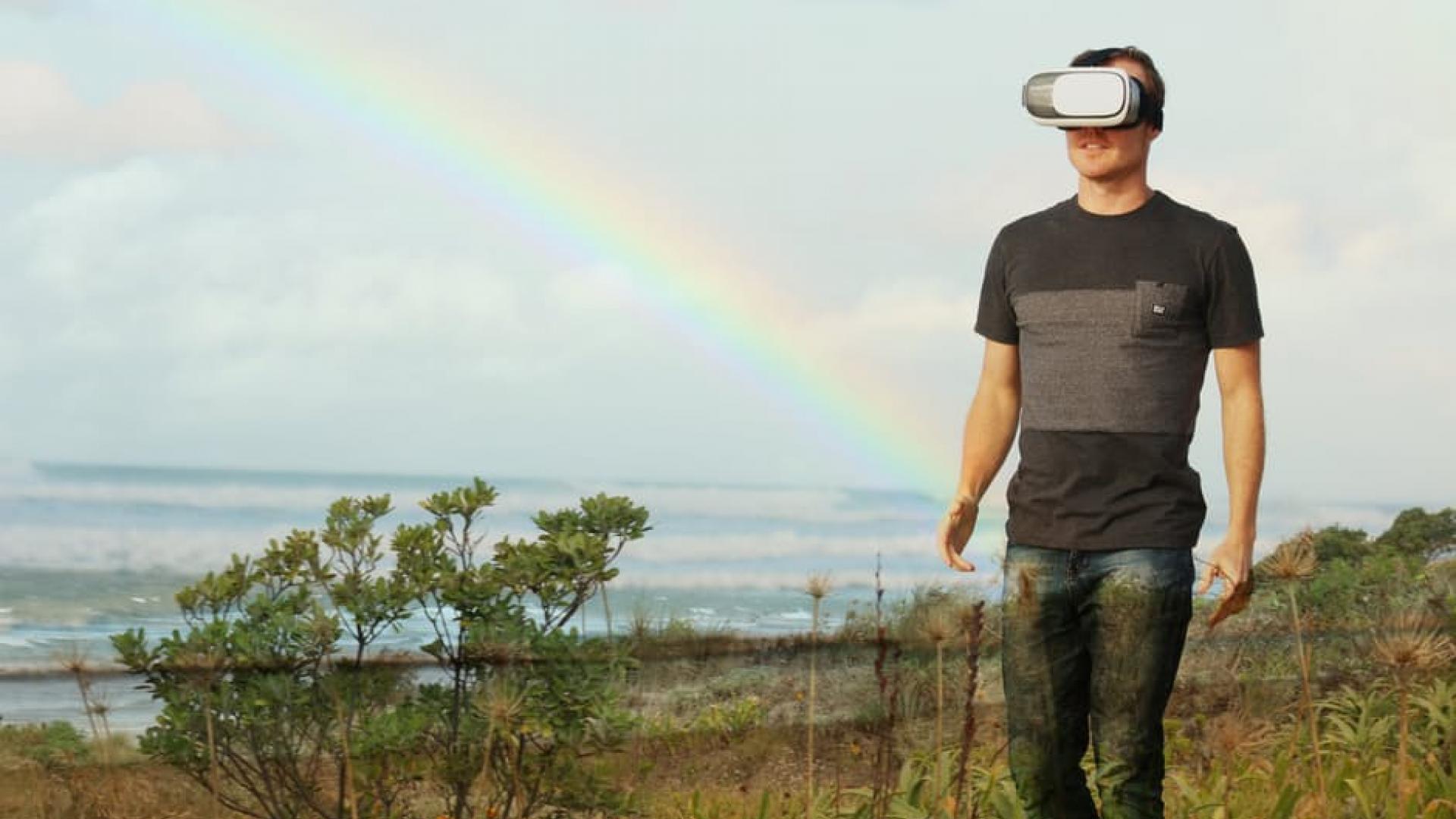
Figure 1: Greenpeace’s Spring 2017 issue of Connect magazine, Source: Blippar.com
The environmental charity Greenpeace added a virtual reality aspect to its Spring 2017 magazine. Using the virtual reality app Blippar, supporters could scroll over a page to “see it come to life”. As someone who is new to virtual reality, I downloaded the free app straight away.
I scanned the cover of the magazine, which is a picture of pieces of household objects floating deep in the ocean. The app brought me to similar photographs by Mandy Barker and the story about how the plastic debris entered the ocean after the Japanese Tsunami in 2011. With more scanning, I found out more about Greenpeace’s ocean plastics campaign, watched selfie videos and explored the newly discovered Amazon reef.

Figure 2: Greenpeace’s Spring 2017 issue of Connect magazine
Some charity newsletters have repeatedly asked me to donate. But with Greenpeace’s magazine I felt I could get involved without just giving money, which appealed to me as a lapsed donor who is still interested in the cause. Our research found that the single biggest reason why regular donors stopped or decreased their charitable donations was a drop in pay or increase in financial responsibilities. Readers can feel part of the organisation’s work by signing petitions and sending “burning questions” for Greenpeace to answer, even if they are unable to donate for personal reasons. I could share a campaign video on social media, or watch a video informing me about what actions I could take to help save the Amazon from destruction.
For readers that did choose to give, the donation form could be scanned and sent to Greenpeace’s online donation page. For someone like me who regularly makes online payments but rarely posts letters, being reminded by the magazine to donate and then being sent to the online donation page with one click would be really useful. However, the Blippar app was sometimes slow to respond and I became frustrated and gave up trying to scan some pages. Our research has shown just how impatient the public are on their phones, with 43% of respondents stating that they would give up on donating online or by their phones if it took more than 5 minutes.
Other charities have also used virtual reality for various aims. The National Autistic Society used a virtual reality headset to help people without autism to understand what it is like to live with autism on a daily basis. Trinity Hospice in London is giving patients the opportunity to enjoy experiences they may not be able to during palliative care. However, it’s not yet clear if these new experiences increase donations. I haven’t donated to Greenpeace since the magazine came through the door, but I did write a personalised message for their petition on this issue, and I can’t remember the last time I did that for Greenpeace.
What are your thoughts on the use of virtual reality technology in the charity sector? Please tell us what you think by leaving a comment in the comments section located beneath the social sharing buttons.
Hi
Hi
There is some confusion over the use of technology in the charity sector and how effective it is. The example here for Greenpeace is not VR but AR (augmented reality). AR through an app like Blippar simply uses images recognition to overlay or direct a user to online content such as video content, web pages etc. The two applications are very different when looking at within a giving environment. AR is best deployed on direct mail or other printed material to encourage a new potential or existing donor to engage - this is very much a direct action. VR is very much more for an awareness campaign within a controlled environment such as event or pop up stand at a railway station etc. It can be used on DM or printed material but at the moment the take up would be very small as the donor would need to have access to a viewer.
If anyone wants to know more about how this technology can be used effectively to drive awareness, as was done with the National Autistic Society - let me know and I can help. AR and VR are very much the future of campaigning and fundraising as a collaborative channel, but with two very different goals.
Graeme
Hi Graeme,
Hi Graeme,
Thank you for your insights. I would love to know more about the technology out there and how it has/can be used effectively.
Thank you for highlighting
Thank you for highlighting the differences between virtual reality and augmented reality. Virtual reality is used as an umbrella term for both AR and VR in this blog post for ease, but it is important to note the differences. This is an area of interest for us and we will continue to look at how AR and VR will affect the future of campaigning and fundraising.
We are currently compiling a list of charities that have used VR or AR successfully. Please let us know if you know more charities that you think have effectively utilized these new technologies.
Me again. If you want to see
Me again. If you want to see what Greenpeace have done using VR last year, take a look at the link.
https://www.youtube.com/watch?v=Mq6hIluzvcQ
Not the best use case of VR but you will get the idea. To gain the best level of empathy the viewer needs to be taken on a joint journey with someone explaining what is happening and why - you need to experience it with them. The view when outside of the ship on the ice is unfortunate as it is not a realistic viewpoint - it should have been done from the deck as a 'first person' view. Overlaying music reduces the impact as the brain knows it is not real. Maximum impact through audio is using 3D or binaural sound, but this has to be planned before filming. It will be a learning curve for adopters, but it has to be right especially for the charity sector or it will be discarded. The second link below shows an excellent use of VR to increase feelings of empathy and understanding about autism.
https://www.youtube.com/watch?v=DgDR_gYk_a8&t=54s
Thanks
Graeme

